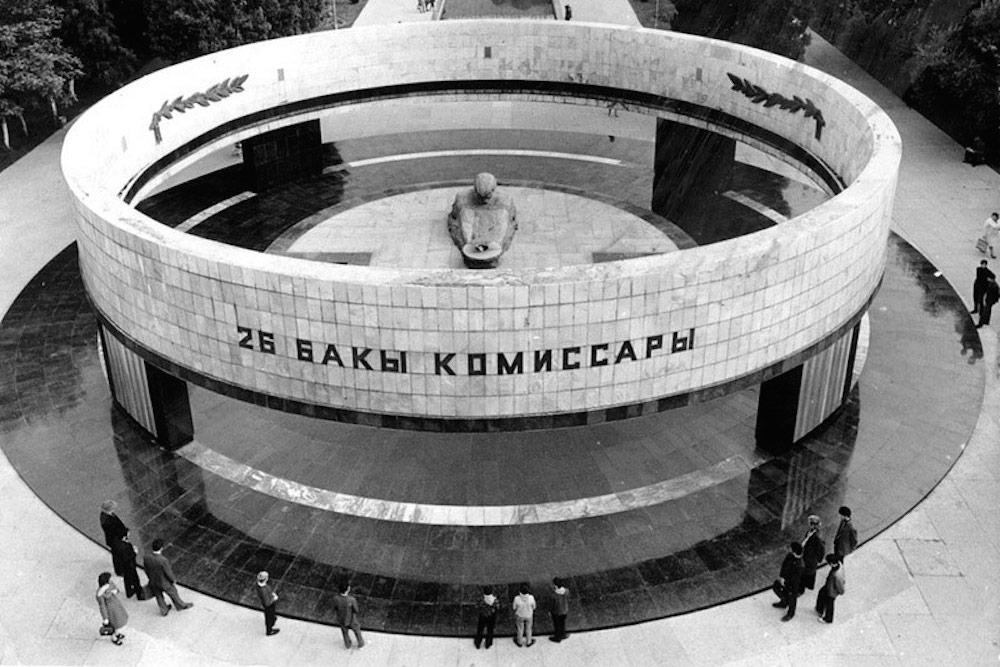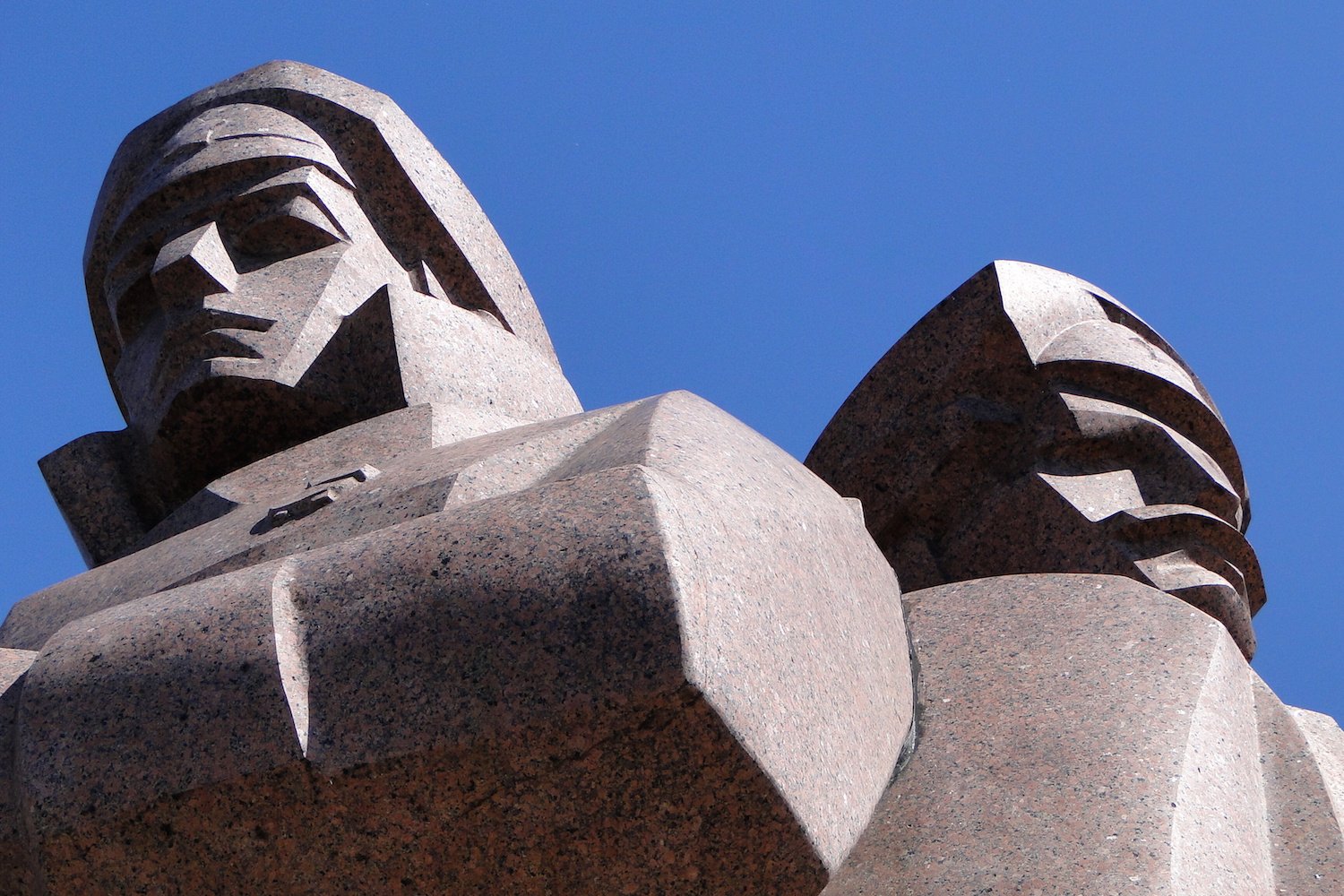No stone unturned: Owen Hatherley on what monuments to the Revolution tell us about 1917
The former Soviet Union is dotted with statues, memorials and other monuments to the glories of 1917. Owen Hatherley takes us on a tour of these (often unwelcome) reminders of the past, and asks whether they still have something to teach us
In 2011, the artist Mykola Ridnyi made a short film called The Monument. Its subject was a sculpture dedicated to the establishment of Soviet power in Ukraine, which was erected on the 50th anniversary of said event in the industrial city of Kharkiv. The sculpture is – or rather, was – interesting, because unlike so many Soviet sculptures, it wasn’t in the likeness of a known leader; instead it tried to encapsulate the revolution through four unnamed figures, representing social classes. Of course, these were made generic through the angular “severe style” of late, post-Stalinist Socialist Realism – chiselled-cheeked male and female workers and soldiers. But they tried in their lumbering way to represent the people who marched into history in 1917 and 1918: the ordinary people of the Russian empire, who in their millions participated in strikes, in seizures of land from landlords, in uprisings, in the workers councils (the “soviets”), in running their own factories.
Ridnyi’s film shows workers of the 21st century blankly dismantling this representation of their great-great-grandparents, chipping away at the granite veneer of the monument to reveal the concrete underneath; just another day’s work. The monument was dismantled without any fanfare – unlike the dismantlement of Kharkiv’s colossal Lenin statue a few years later, which saw demonstrations and counter-demonstrations – as part of the prettification of Ukraine’s second city in time for the 2012 European football championship.
For some commentators, Putin is a communist (as well as a self-enriching capitalist), ruling an extension of the Soviet Union as a new Lenin or Stalin. Yet this commonplace contrasts with the frequently observed fact that the Russian President is terrified of a popular revolution against his rule. Very plausibly, the annexation of Crimea and the proxy war in Donbas were seen in the Kremlin as a means of proving that revolution doesn’t work, crippling post-Maidan Ukraine and plunging it into a ruinous financial and identity crisis (something that has indeed happened, albeit at the cost of ensuring a likely permanent enmity towards Russia). But what official history in each of these successor states to the USSR can surely agree on is that the revolution of 1917 was totally illegitimate. The now-common description of October as a “coup” (with foreign assistance of course – those Germans with their sealed trains) strangely mirrors the way that Russian media described Yanukovych’s overthrow.
The USSR itself struggled to build monuments to the revolution that weren’t monuments to its leaders.
The Soviet legacy is of course partly rehabilitated in Russia, especially through the official cult of the Second World War (Great Patriotic War), whereas Ukraine has indulged in the expensive and historically dubious cargo cult of “decommunisation”; only the attitude to 1917 is similar. In 2013, long before Ukraine’s “Leninopad”, an obelisk by the Kremlin originally devoted to the Romanov dynasty, rededicated in 1918 to “Revolutionary Thinkers” from Fourier to Marx, was redesigned back into its tsarist form. On the other side of the Kremlin Wall, however, Lenin’s body and Stalin’s grave stand untouched. As leaders, they can – with some difficulty in the case of Lenin – be seen as great state builders, and hence be accorded respect. The mass of revolutionaries cannot.
The USSR itself struggled to build monuments to the revolution that weren’t monuments to its leaders. The typical edifice may be that at Kaluzhskaya (formerly October) Square in Moscow, built in 1985 – swarming tiny figures sweep around doing swashbuckling and revolutionary things, underneath a giant Lenin, directing them. More subtly, many cities still have plaques to the events of 1917 and its rank and file participants, and they often go almost unseen, unless in Ukraine some attentive decommuniser has spotted them. On Lenin Street in Minsk, at the junction with Freedom Square, is a plaque recording, in Belarusian, that the local Soviet of Workers and Soldiers Deputies, those radical, unstable institutions of direct democracy, met there in 1917. Recently, teaching a group of architectural students working on said square, I found they’d never noticed the plaque, indistinguishable from literally hundreds of others dedicated to worthies and important events of the Soviet calendar all over the city.

In St Petersburg, factory districts like the Vyborg Side, Vasilevsky Island and Narvskaya Zastava have many undemonstrative plaques to ordinary revolutionaries or to factory councils (“Worker-Revolutionary and Bolshevik Agitator of the Putilov Works”, and so forth). In one area of old textile factories, there is a strange monument to unnamed children who died in October 1917, otherwise unknown to history. But the largest Soviet monuments here are those to the war, or to Lenin – the city has the earliest extant Lenin statue, outside Finland Station, a 1926 design showing him atop an abstracted version of the armoured car from which he addressed Petrograd workers as he returned from exile in April 1917.
St Petersburg does have the only major monumental space dedicated to the events of 1917 that could plausibly be said to be built by, rather than for, the revolution. The Field of Mars is a tsarist parade ground round the back of a great counter-revolutionary monument, the Cathedral of the Saviour on the Spilled Blood (built on the site of Tsar Alexander II’s assassination in 1881). It is here that those killed during the February revolution in 1917 – the precursor to October that saw the fall of the Romanovs – were buried. Under red granite stars are the bodies of 184 protesters killed in street fighting that year. They are unnamed, but prominent Bolsheviks killed in the Civil War were later buried with them under stones bearing their names. The monumental space was completed in 1919 to the designs of Lev Rudnev – ironically, notorious decades later as a Stalinist architect – with poetic inscriptions by the Commissar of Enlightenment, Anatoly Lunacharsky, declaring that “not victims but heroes” lie therein. It is an open, democratic space, flat and anti-hierarchical.
The USSR itself struggled to build monuments to the revolution that weren’t monuments to its leaders
The “Russian revolution” began in February 1917 and that didn’t really end until 1921, when the Bolsheviks crushed their opponents to the right (various US- and European-backed restorationist armies) and left (the Kronstadt sailors, whose mutiny was bloodily suppressed). It also took place far outside of Russia itself. Aside from Kharkiv’s destroyed commemoration, Kiev still has a monument to the Arsenal Uprising, where the city’s Soviet of Workers and Soldiers’ Deputies tried to seize power from the nationalist Central Rada: a small gun emplacement atop a granite plinth, defaced and with its inscription partly removed. Similarly, Azerbaijan, Latvia and Estonia, which along with Finland (which never became part of the USSR) were among the most strongly leftist parts of the Russian Empire, have numerous monuments to revolutionary events.
Latvians were disproportionately represented in the Bolshevik Party, as befits one of the more industrialised parts of the Empire; the division of Latvian riflemen formed in the First World War represented the backbone of the Red Army. A Monument to the Riflemen, standing serene and sinister like a trio of Cubist sentinels, still stands in the centre of Riga, in front of what was once their own dedicated museum (now the Museum of Occupation). In Latvia even small towns have scattered plaques and monuments attesting to the intensity of revolutionary fighting – in Kuldiga, for instance, every action of the local Soviet is recorded on a weary plaque, and twisted figures representing the massacre of Communists by occupying German Freikorps in 1919 stand in the town park. In Baku, which was for a time under the rule of a radical and violent Commune, an ambitious, space-age monument dedicated to 26 murdered revolutionary commissars was destroyed in 2009. Allegedly this was not so much because the revolutionaries were Communists, but because many of them were Armenian.

Some days before Soviet power was proclaimed in Petrograd, it had already been proclaimed in Tallinn, when the local Soviet took over the Baltic port. A monument to the workers and sailors stands near the city walls, a hulking superman symbolising the unseen people whose names are inscribed nearby. The names are Estonian, German and Russian, in that order. And here is one of the things that make 1917 uncomfortable for governments all over what was, a hundred years ago, the Russian empire. 1917 was international, as were its effects – a wave of insurrection and unrest, mostly abortive, from Budapest to Berlin, Glasgow to Turin, Limerick to Odessa. Its aim was not the creation of nation states, nor even the strange morphing of the Russian empire into the putatively international Soviet Union, but a universal republic, with all class and national distinctions dissolved, with power held by the mass of the population. That’s not so easy to cast in stone.
Text: Owen Hatherley
The Future Remains: Revisiting Revolution runs until December 2017 at the Calvert 22 Foundation

